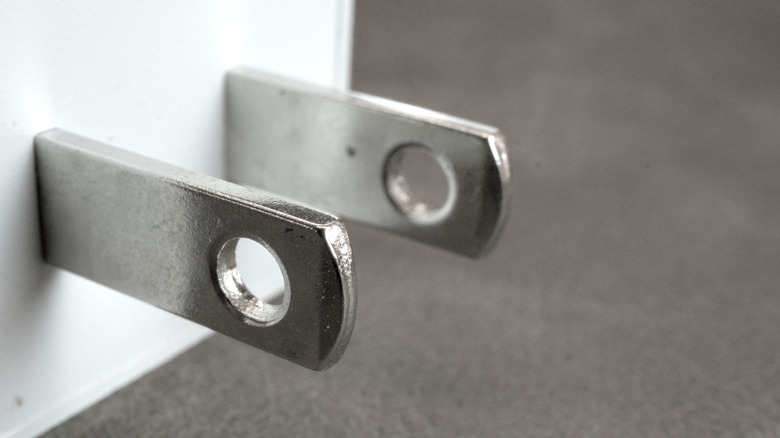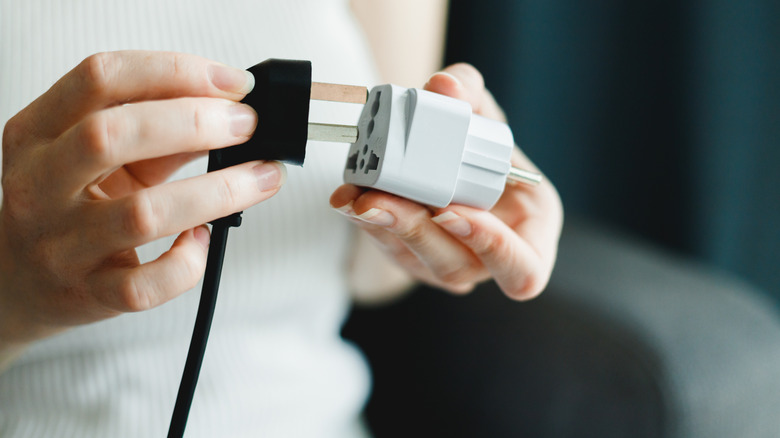What The Holes In Electric Prongs Are Used For
If you've ever stared at the holes in an electrical plug and wondered why they exist, you're not alone. Like an industrial-age kōan, the answer is anything but straightforward. A quick search will present a litany of explanations, ranging from safety measures to pure design tradition. But even among experts, there's no single agreed-upon purpose. Ultimately, the continued use of prong holes seems rooted in tradition, minor manufacturing benefits, and customer expectation rather than any critical functionality.
Historically, these holes were intended for securing the prongs within the outlet, introduced in the first universal plug design by Harvey Hubbell in 1913. Back then, the holes connected with interior bumps in the outlet to prevent accidental disconnection, an important safety measure for early electrical systems. However, most modern outlets don't use this mechanism anymore, leaving the holes as vestiges of a past design standard that has persisted despite changes in technology. Another common theory suggests that the holes help with grounding or improving electrical connectivity. Some claim that the metal edges around the holes can scrape off oxidation when inserted, ensuring a better connection. Today, however, there are around 10 types of electrical outlets found in most homes, very few of which might actually benefit from this design.
While these explanations hold some technical merit, industry standards don't actually require the holes for any of these purposes. According to the National Electrical Manufacturers Association (NEMA), the holes are entirely optional. Even the American National Standards Institute (ANSI), which sets guidelines for electrical equipment, does not mandate the inclusion of holes in prong design. In short, while the holes have a long history and a handful of speculative functions, their presence today doesn't serve any functional purpose.
The holes might play a role in safety and manufacturing
The debate over why these holes persist is almost as old as the design itself. Proponents of the retention theory — maintaining electrical current by material contact — argue that the holes still serve a mechanical purpose in certain outlets designed to latch onto the plug. NEMA documentation confirms that in some specialized locking connectors, the holes do help the plug stay in place. But for the vast majority of standard North American outlets, these holes are entirely unused. A dissection of modern outlets often reveals no mechanism engaging with the prong's holes, leading many to believe that their continued existence is largely aesthetic or even nostalgic. It can also be noted that more modern outlets have 3 prongs while older ones only have 2, and that the modern third prong is usually hole-less.
Another theory centers around cost-effectiveness, suggesting that manufacturers save money by reducing raw material costs through this design. Theoretically, manufacturers can save a fraction of raw material per plug by following this design, but there is no evidence of significant savings. Similarly, the holes could make manufacturing easier by allowing automated assembly machines to grip the prongs more securely during production. In a purely industrial sense, the holes help streamline the manufacturing process. There are also minor safety claims. Some argue that the holes allow for lockout devices to be attached during factory assembly or maintenance, preventing unauthorized use. While this is technically true, it's hardly necessary to have such a function on standard home electronics and appliances.
Plenty of plugs don't have these holes
While the familiar North American two-prong plug (Type A) and its grounded, 3-prong cousin (Type B) almost universally feature these holes, not all prongs are created equal. European plugs, for instance, typically lack these holes entirely, as their safety standards prioritize direct grounding mechanisms over mechanical retention. The Schuko plug, one of Europe's most common designs, relies on a robust grounding mechanism that doesn't require prong holes to maintain a secure connection. This is largely due to European safety standards that prioritize direct grounding over mechanical retention. Similarly, the British three-pin plug (Type G) forgoes prong holes in favor of a built-in fuse and thicker prongs designed for extra stability.
Even within North America, specialty plugs often omit these holes. High-amperage industrial plugs and certain appliance-specific designs, such as the 240-voltage power outlets you might see when you hook up your washer and dryer in the laundry room, reflect more modern safety standards that don't require a hole in the plug. In contrast, NEMA locking connectors, often used in heavy-duty settings, do make use of the holes for secure latching, proving that the original purpose still holds some weight in niche applications.
Ultimately, the presence of holes in prongs is a mix of tradition, some utility, and customer expectation. Their persistence in North American plugs is less about necessity and more about a design that's simply stuck around. Not unlike imperial units of measurement and the Fahrenheit temperature scale, it's a quirk of history that lingers in our everyday lives.


